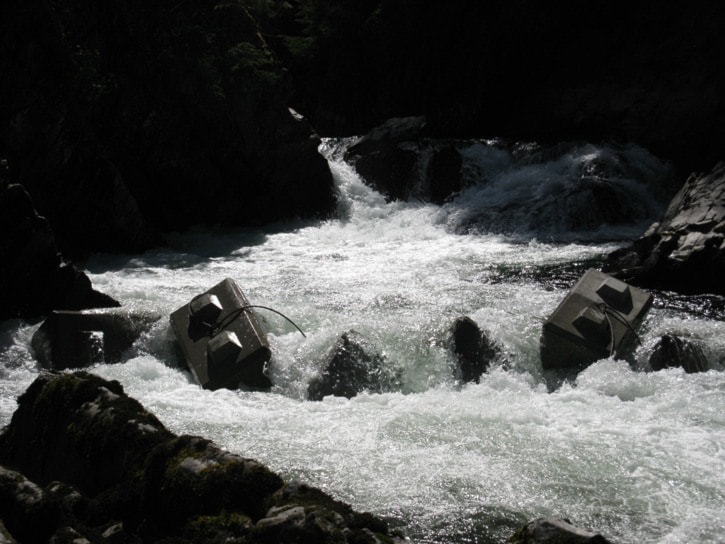Kwinageese River salmon are once more making their way to their spawning grounds after biologists and engineers crafted a plan to help them clear a waterfall that had been blocking their passage.
A helicopter was used to place heavy concrete blocks in a pool at the bottom of the waterfall, thus raising it so the salmon would not have to leap as far to clear the waterfall.
The waterfall was caused when slabs of rock sheared off and tumbled into the river.
Bob Bocking, a biologist with the environmental consulting firm LGL which is contracted to the Nisga’a Fish and Wildlife Department, said everything from permits to stockpiling the concrete blocks as close to the waterfall as possible came together perfectly.
“It’s pretty exciting,” said Bocking of figures indicating 4,700 sockeye and more than 600 chinook had passed a counting weir within several days of the blocks being placed late in the afternoon of August 12.
By August 17, approximately 9,000 sockeye had passed the counting weir.
The pool was raised approximately one meter, meaning the salmon had to leap approximately two metres which is within their capabilities.
“At three metres, that’s pretty much impossible,” said Bocking.
Biologists began wondering what was wrong with the Kwinageese River salmon run, which is part of the Nass River run, after returns dropped off dramatically beginning in 2009.
“We knew by DNA at the fish wheels there were lots but they didn’t make it to spawn,” said Bocking.
Biologists first thought low water might be a reason but soon turned their thinking to the possibility of some sort of blockage. A survey of the Kwinageese resulted in finding the blockage on July 26.
Bocking said Nisga’a officials and biologists and DFO officials discussed airlifting the salmon over the falls but dismissed the idea as time consuming and expensive.
“We talked about blasting but getting a permit in the middle of the [salmon] run was out of the question,” he said.
There was some thought given to constructing and installing a fish ladder made out of aluminum but that would have taken too long to put into place.
That’s when Bocking came up with the idea of raising the pool and recruited recently retired DFO engineer Don Hjorth to design a program.
A first idea to use large rocks was shelved because of the challenge of how to get them to the location.
Large concrete blocks weighing 4,500 pounds commonly used to stabilize slopes were chosen instead and purchased from Skeena Concrete.
Planning began Aug. 4 leading to a work plan being submitted Aug. 8 followed by receiving government approvals the next day.
That set in motion getting the 44 concrete blocks to the area, a five and a half hour journey which begin early in the morning of Aug. 12.
“We also had to inspect 13 bridges along the road just to make sure they could handle the load,” said Bocking.
By getting the blocks to within 4km of the work site, helicopter flying time was cut to six and a half minutes a trip.
“The first one was placed at noon and we were done by six p.m.,” said Bocking.
He praised the work of helicopter Tom Schneider from Bear Creek contracting in using a long line to place the blocks where needed.
Costs so far are estimated at $50,000 but that figure will grow because of follow-up monitoring and other work.
The Habitat Conservation Trust Fund has contributed $25,000 with other monies coming the Department of Fisheries and Oceans and the Nisga’a Lisims Government.
Bocking attributed the speed in which the plan came together to the co-operation between the Nisga’a, the federal Department of Fisheries and Oceans, the BC Water Management Branch and the provincial fisheries branch.
“Everybody scrambled and everybody came together on this,” he said of the various officials and departments involved.
Even though the Kwinageese run is only about five per cent of the entire Nass run, the impact of having so few spawners return home was widespread. That’s because DFO and Nisga’a fisheries officials both restricted Nass sockeye openings in order to have as many Kwinageese salmon as possible return to spawn.
“Fishing plans are now structured to protect all stocks so to protect a weaker run like the Kwinageese, the larger fishery was affected,” said Bocking.
“So a lot of commercial fishermen should be breathing a sigh of relief,” he added.
